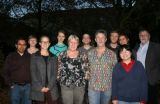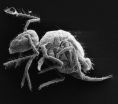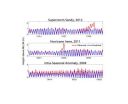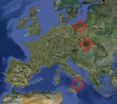(Press-News.org) Chapel Hill, NC – In a paper published in the Nov. 21 issue of Cell, a team led by Mauro Calabrese, a postdoctoral fellow at the University of North Carolina in the lab of Terry Magnuson, chair of the department of genetics and member of the UNC Lineberger Comprehensive Cancer Center, broadens the understanding of how cells regulate silencing of the X chromosome in a process known as X-inactivation.
"This is a classic example of a basic research discovery. X-inactivation is a flagship model for understanding how non-coding RNAs orchestrate large-scale control of gene expression. In the simplest terms, we are trying to understand how cells regulate expression of their genes. Our findings are relevant across the board -- by understanding how normal cells function we can apply that knowledge to similar situations in the understanding and treatment of disease," said Calabrese.
Proper regulation of the X chromosome plays a crucial role in mammalian development. Females inherit a pair of X chromosomes from their parents, and the process of X-inactivation shuts down one of these two Xs.
"Males have XY. Females have two Xs. One of those Xs needs to get shut off. If it does not, it's not compatible with life. It's how we have evolved to equalize doses between males and females," said Calabrese.
While the manner in which the X chromosome is deactivated has been actively studied for 50 years, the exact mechanisms that regulate the process remain a mystery. Calabrese's research used high-throughput sequencing to determine the location and activity of chromosomes with far greater accuracy than previous research.
"Basically, this is using the sequencing technology as a high resolution microscope," said Calabrese.
Under a microscope, the inactive X chromosome (Xi) appears as a cloud-like structure, because it is covered with a non-coding RNA known as Xist. In the traditional model of X-inactivation, genes located inside the cloud are completely silenced, with 15 percent of the genes from the inactive X chromosomes escaping to become active.
"The prevailing thought was that genes that escaped X inactivation were pulled out of the core and expressed out there," said Calabrese.
The work of Calabrese's team complicates the current model of X-inactivation by finding indications of gene activity inside the Xist cloud and the presence of inactive genes outside the cloud, both of which would not have been thought possible in the prevailing model.
"It's kind of a subtle thing, but mechanistically it is a big difference," said Calabrese.
Inside the Xist cloud, sequencing discovered traces of DNase I sensitivity, a feature usually linked to transcription activity. While other markers associated with transcription were absent, the presence of DNase I sensitivity suggested that the nucleus did recognize the inactive X as usable DNA, but an unknown suppressive mechanism was preventing genes from being activated.
"We were surprised to see that. If they were totally silent, you would expect this to be not there… This suggests that transcription factors or other proteins that bind DNA are still accessing the inactive X," said Calabrese.
The other surprising findings involve the 15 percent of "escaper" genes from the inactive X. Calabrese found evidence that active genes were found both inside and outside the Xist cloud, and that silenced genes that lay alongside active genes outside of the Xist cloud remained inactive.
"If X-inactivation was a strict nuclear barrier, then pulling a gene outside the barrier would turn it on, but it has got to be more than that because when an inactivated gene that is beside an escaper is outside this domain, it is still turned off," said Calabrese.
The presence of DNase I sensitivity within the Xist cloud and the finding of inactive genes outside of the cloud suggest that a site-specific mechanism is regulating genes on the chromosome in a more subtle way than the binary "on/off" function posited by the prevailing model. The exact mechanism for this remains unknown. Although Calabrese believes that Xist still plays a role, its exact function and whether other factors influence X-inactivation remain questions for future research.
"We know that Xist is required to turn off the inactive X. We know that. We have no idea how" said Calabrese.
Beyond revising the understanding of how X-inactivation works, Calabrese said that deeper understanding of the function of Xist could reveal more about the role of other non-coding RNAs in cellular development. These RNAs could become useful targets for future therapies and drug development.
"We know that too much expression of the wrong non-coding RNAs can lead to cancer. Also, forced expression of other non-coding RNAs can prevent cancer. Generally, we do not know how these RNAs work," said Calabrese.
### END
Philadelphia, PA, November 27, 2012 – Posttraumatic stress disorder (PTSD) is a form of learning that begins at the moment of the exposure to extremely stressful situations and that grows in impact as trauma-related memories are rehearsed and strengthened repeatedly. This somewhat oversimplified view of PTSD yields a powerful prediction: if one could disrupt the rehearsal and strengthening of traumatic memories, a process called reconsolidation of memories, then one might reduce PTSD risk or PTSD severity after potentially traumatic events.
To be certain, it is tricky ...
In a new study published in the scientific journal Circulation, scientists at Karolinska Institutet and Karolinska University Hospital in Sweden show that an enzyme called arginase might have a key part to play in the development of cardiovascular disease in patients who already have type II diabetes. According to the team, arginase prevents the formation of protective nitrogen oxide in the blood vessels, and treatments that inhibit this enzyme reduce the risk of angina in diabetics.
"The fact that we could demonstrate the presence of arginase in several types of cell ...
Malaria is a life-threatening disease that strikes more than 200 million people every year – mainly in Africa, Asia and Latin America. The disease is caused by the Plasmodium parasite, which is spread by infected mosquito bites. Today, malaria can be prevented and successfully treated, but more than half a million people nevertheless die every year from the disease.
Large-scale monitoring and treatment programmes during the past decade have reduced the distribution of the disease, and the frequency of actual epidemics has fallen. However, the number of malaria patients ...
Field and laboratory work by a group of zoologists led by Omar Torres-Carvajal from Museo de Zoología QCAZ, Pontificia Universidad Católica del Ecuador, has resulted in the discovery of a new species of blunt-headed vine snake from the Chocoan forests in northwestern Ecuador. This region is part of the 274,597 km2 Tumbes-Chocó-Magdalena hotspot that lies west of the Andes. The study was published in the open access journal ZooKeys.
Blunt-headed vine snakes live in an area comprising Mexico and Argentina, and are different from all other New World snakes in having a very ...
A team of scientists from the University of Navarra and the Catalan Association of Biospeleology have discovered three new collembolan species in the Maestrazgo caves in Teruel, Spain. Their description has been published in the Zootaxa journal. These minute animals belong to one of the most ancient animal species on the planet.
The Maestrazgo caves in Teruel are located in a region of the Iberian Range where fauna has not been the subject of much study. It is a very isolated region since its average altitude is between 1,550 m and 2,000 m asl and its climate can be described ...
Researchers at the University of Liverpool have developed a computer-based test that could help heavy drinkers reduce their alcohol consumption.
Regular heavy drinking can lead to serious health conditions such as liver and heart disease, costing the NHS millions of pounds every year. Research at Liverpool has shown that the habit of consuming alcohol can be interrupted when people practice methods of restraint whenever they see images of alcoholic drinks.
The team developed a computer test that required participants to press particular buttons when an image of alcohol ...
Uncertainty about how much the climate is changing is not a reason to delay preparing for the harmful impacts of climate change says Professor Jim Hall of the Environmental Change Institute at the University of Oxford and colleagues at the Tyndall Centre for Climate Change Research, writing today in Nature Climate Change.
The costs of adapting to climate change, sea-level and flooding include the upfront expenses of upgrading infrastructure, installing early-warning systems, and effective organisations, as well as the costs of reducing risk, such as not building on flood ...
The effects of storm surge and sea-level rise have become topics of everyday conversation in the days and weeks following Hurricane Sandy's catastrophic landfall along the mid-Atlantic coast.
Ongoing research by professor John Brubaker of the Virginia Institute of Marine Science is throwing light on another, less-familiar component of sea-level variability—the "intra-seasonal" changes that occupy the middle ground between rapid, storm-related surges in sea level and the long-term increase in sea level due to global climate change.
"These are cases when the water is ...
Chromosome number is the most basic feature concerning the genome of a species, and it is known for about one third of higher plant species. In particular, for plants of Italy, Slovakia, and Poland, online chromosome number databases have been developed: 'Chrobase.it – Chromosome numbers for the Italian flora', 'Karyological database of ferns and flowering plants of Slovakia' and 'Chromosome number database – PLANTS', respectively. The three datasets account for about 35%, 60% and 40% of the whole floras, respectively.
"We used these datasets to compare chromosome number ...
MANHATTAN, Kan. -- When it comes to stopping illness, social media posts and tweets may be just what the doctor ordered.
A Kansas State University-led research team is looking at social media as a tool to reduce and prevent diseases from spreading. Researchers are studying whether a well-timed post from a public authority or trustworthy person could be as beneficial as flu shots, hand-washing or sneezing into an elbow.
"Infectious diseases are a serious problem and historically have been a major cause of death," said Faryad Sahneh, Kansas State University doctoral candidate ...





